Index
4.4 Species verification

The species verification tab houses a set of tools to assist in the quality control of acoustic tags. In species verification, administrators assign users as validators to verify all tags grouped from a species-vocalization type in a project. Species-vocalization type is used for the grouping to allow the user to focus on one signal type at a time, e.g. Wilson's Snipe (WISN) calling vs. winnowing. Species verification is important because it allows you to efficiently check all the tags produced in a project before publishing it, thereby dramatically increasing data quality output.
The philosophy of ARU species verification in WildTrax is a two-stage approach:
- 1) Create or import tags in a project
- 2) Verify all the tags of a species-vocalization type
This allows a WildTrax user to have the first pass at processing the acoustic data and then use the verification tools to target and verify tags. Verification tags are populated once the task in completed (or switched to Transcribed). Clicking on the  tab in the project page displays a list of species-vocalization types, summaries of the total number of verified tags, and tools to assign users for verification, in order to help you manage the verification process. Click on any of the species to enter the verification page.
tab in the project page displays a list of species-vocalization types, summaries of the total number of verified tags, and tools to assign users for verification, in order to help you manage the verification process. Click on any of the species to enter the verification page.
-
Verification of human-generated tags
This is the standard practice currently used in WildTrax. Use this route if you have trained taggers who will be generating tags from assigned tasks.
- Upload recordings to a project and generate tasks by checking

- Assign users as taggers to the tasks
- Tag all of the tasks in a project
- Assign validators under the
 tab
tab - Verify all of the tags for each species-vocalization type where desired; return to the tasks to change or delete tags where needed
- Filter by verified tags and mark high quality ones as Nice, or mark as Nice as you verify
- Proceed to publishing your verified project
- Upload recordings to a project and generate tasks by checking
-
Verification of classifier hits
If you have outputs from a recognizer and wish to verify the hits and share the results in WildTrax:
- Upload recordings to a project and create tasks
- Upload tags from the automated classifier
- Assign validators under the
 tab
tab - Verify all of the tags for each species-vocalization type where desired; return to the tasks to change or delete tags where needed
- Rate the tags to help determine recognizer performance
- Proceed to publishing your verified project
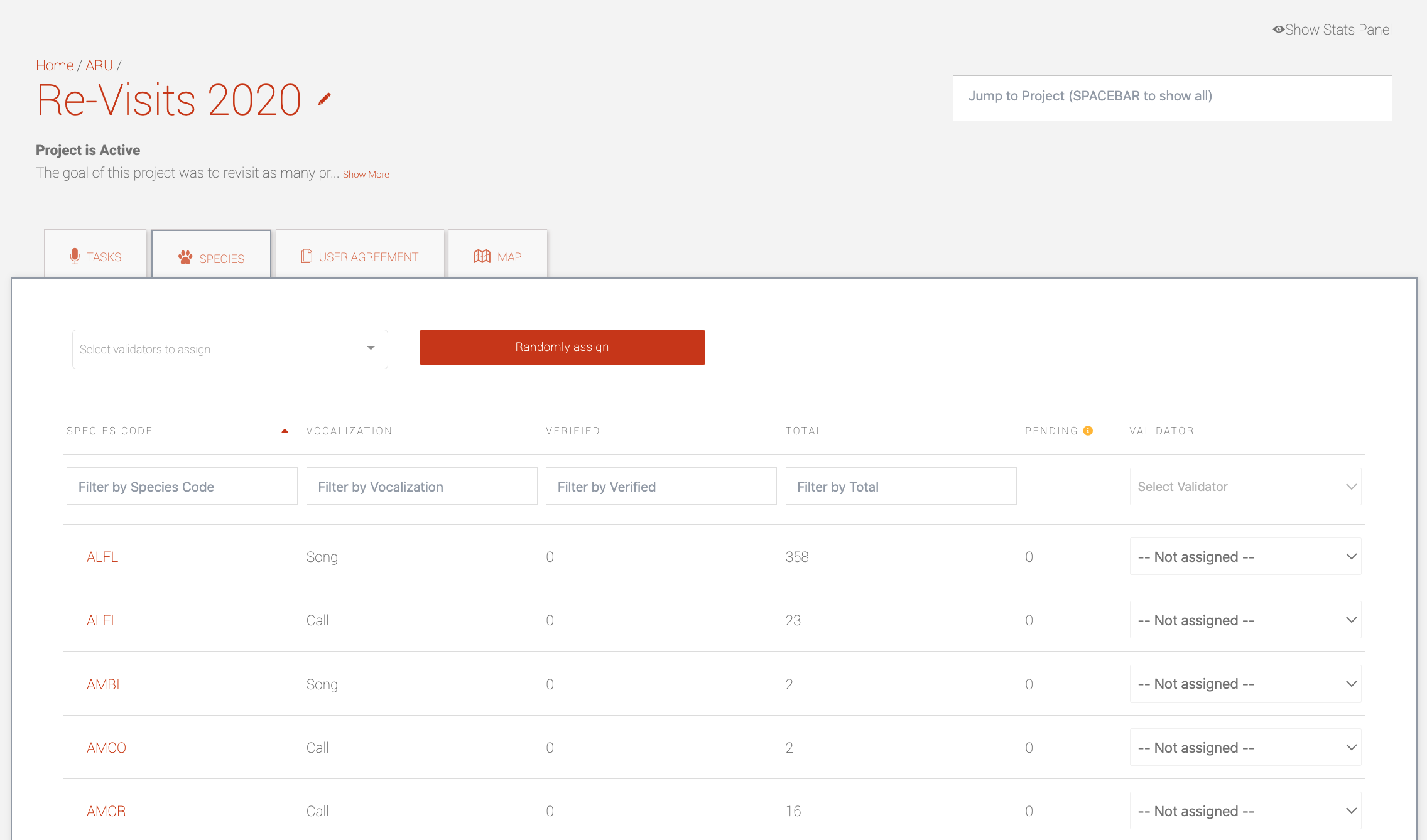
Check with your project administrator for how you should proceed verifying acoustic data for your project.
Verification page
The verification page header designates the species-vocalization type you're verifying and the filters are metadata you can use to filter the list of tags you see in the single tag panels. The single tag panels allow you to individually access and manipulate the audio and spectrogram properties, and take actions in order to verify the tag.
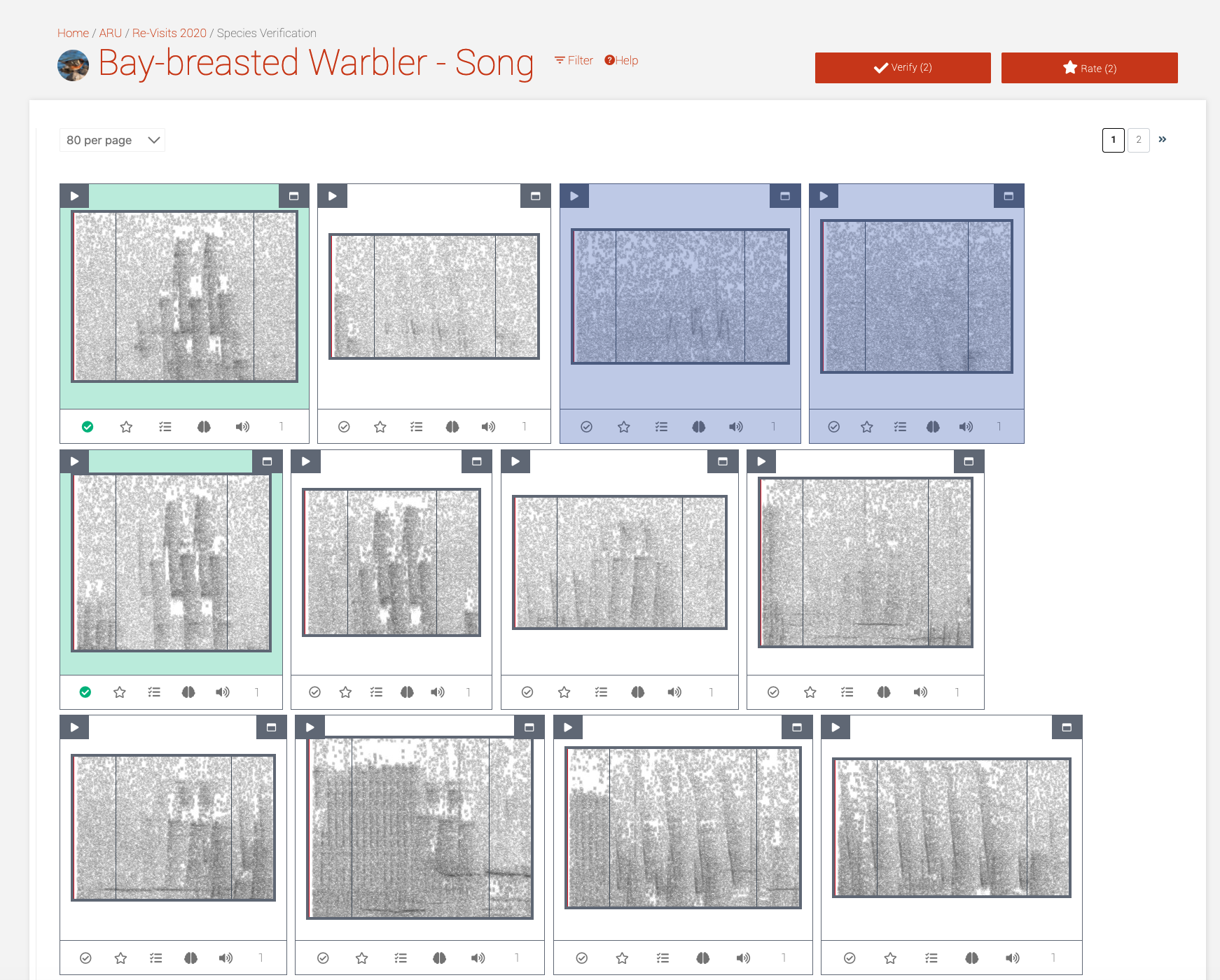
You can listen to any of the audio in the single tag panels by clicking the Play button  in the top-left hand corner. The icons below the spectrogram indicate the following:
in the top-left hand corner. The icons below the spectrogram indicate the following:
- Verify
 : when checked green
: when checked green  , the tag has been verified. The background of the single tag panel will also change to green.
, the tag has been verified. The background of the single tag panel will also change to green. - Rating
 : when checked yellow
: when checked yellow  , the tag has been rated
, the tag has been rated - Task link
 : opens a new tab to the task where the tag was created; the tag will be coloured black in the task
: opens a new tab to the task where the tag was created; the tag will be coloured black in the task - BirdNET probability
 : maximum probability (0-1) returned from BirdNET. The number is the maximum value found in all of the 3-second windows where BirdNET also positively detected the species and intersected the tag.
: maximum probability (0-1) returned from BirdNET. The number is the maximum value found in all of the 3-second windows where BirdNET also positively detected the species and intersected the tag. - Amplitude
 : peak amplitude (in dBFS) of the tag
: peak amplitude (in dBFS) of the tag - Abundance: abundance of the species made in the tag. If TMTT, the icon will appear as

-
What is a tag rating?
Rating tags helps to create a library of high quality acoustic resources and verified datasets. Below are the descriptions of the 5-star rating system (adapted from eBird). You can rate a tag anywhere you see a
 while in species verification.
while in species verification.- 1 Star: Very weak target sound that is barely audible due to high background or handling noise or many overlapping sounds.
- 2 Stars: Weak target sound with significant background or handling noise or many overlapping sounds.
- 3 Stars: Good target sound with moderate background noise or some overlap with other sounds.
- 4 Stars: Strong target sound with limited background noise or some overlap with other sounds.
- 5 Stars: Very strong target sound with little or no background noise or overlap with other sounds.

Tag needs review
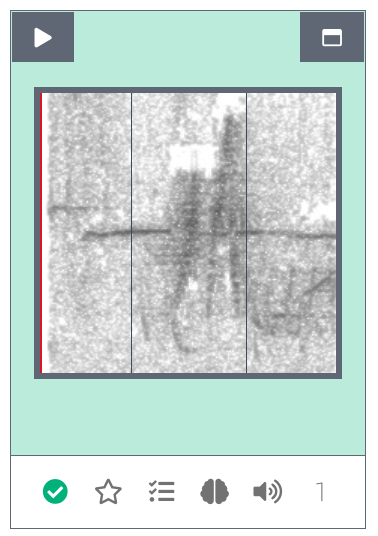
Tag has been verified
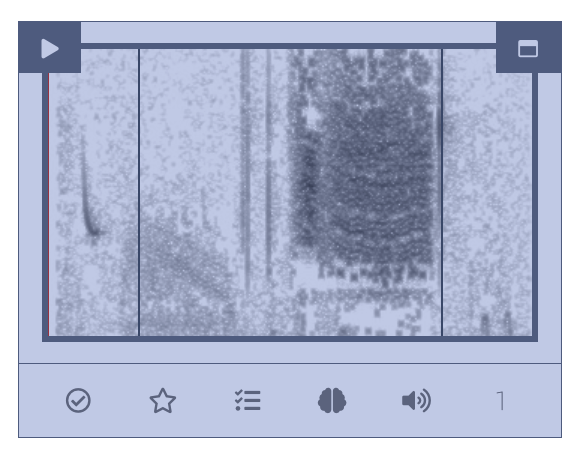
Tag is selected
WildTrax uses the BirdNET API and returns the maximum probability from all the 3-second windows that intersected the tag. Note, results from other species are not returned.

You can also click on the  button which opens the Help menu describing everything from the legend to keyboard shortcuts and tag selection methods so you can customize your verification workflow the way you want.
button which opens the Help menu describing everything from the legend to keyboard shortcuts and tag selection methods so you can customize your verification workflow the way you want.
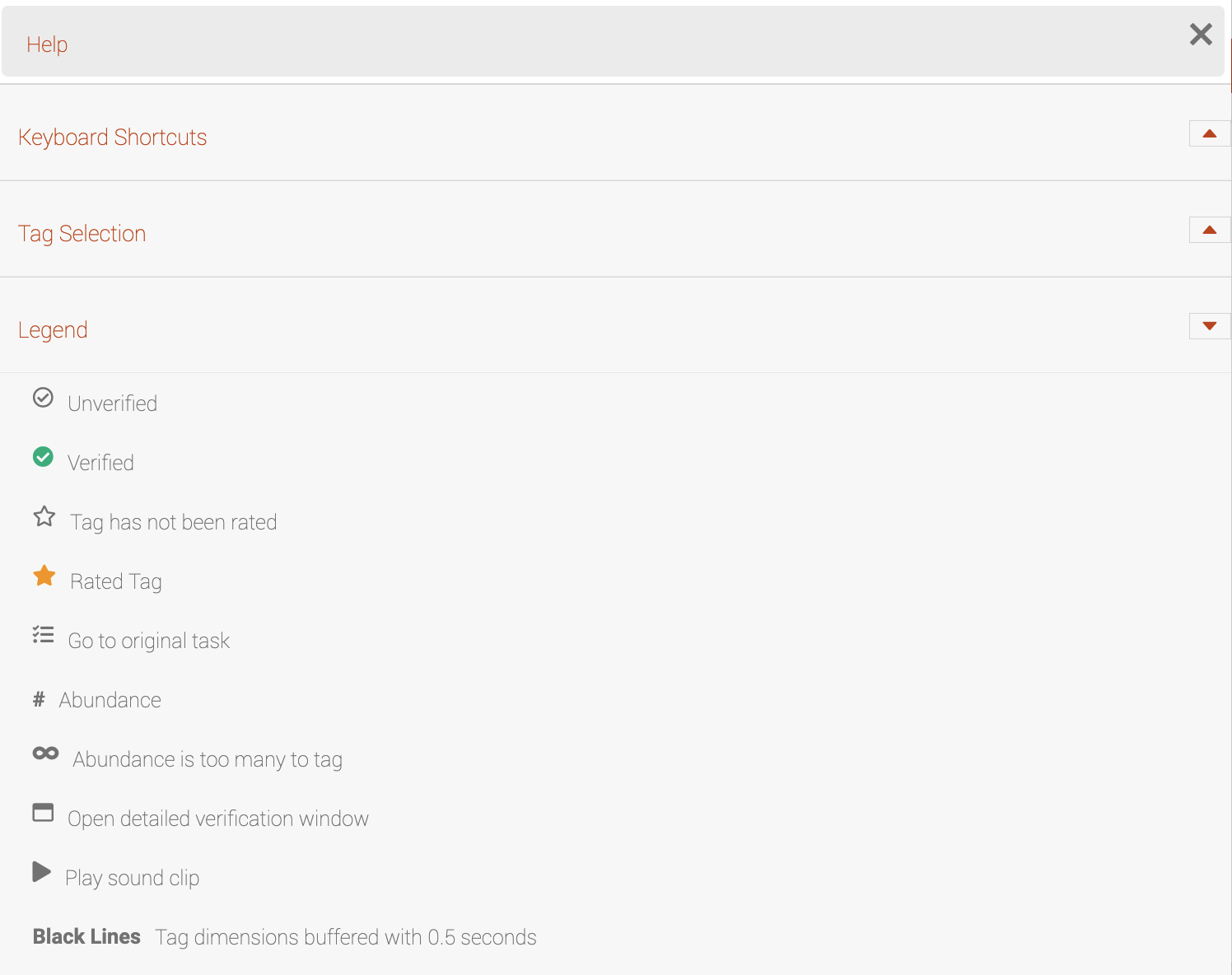
Detailed verification window
Clicking on the top-right corner of the single tag panel  opens the detailed verification window. This window allows you to manipulate the audio and spectrogram parameters in order to verify the tag. The main sections of the detailed verification window includes:
opens the detailed verification window. This window allows you to manipulate the audio and spectrogram parameters in order to verify the tag. The main sections of the detailed verification window includes:
- Task link (in the header)
- Action buttons
- Tag details
- Spectrogram
- Filters
The task link will open a new tab and jump back to the task to view where the tag took place, highlighted the tag in black. This is useful if you need more context beyond what is available in the detailed verification window.
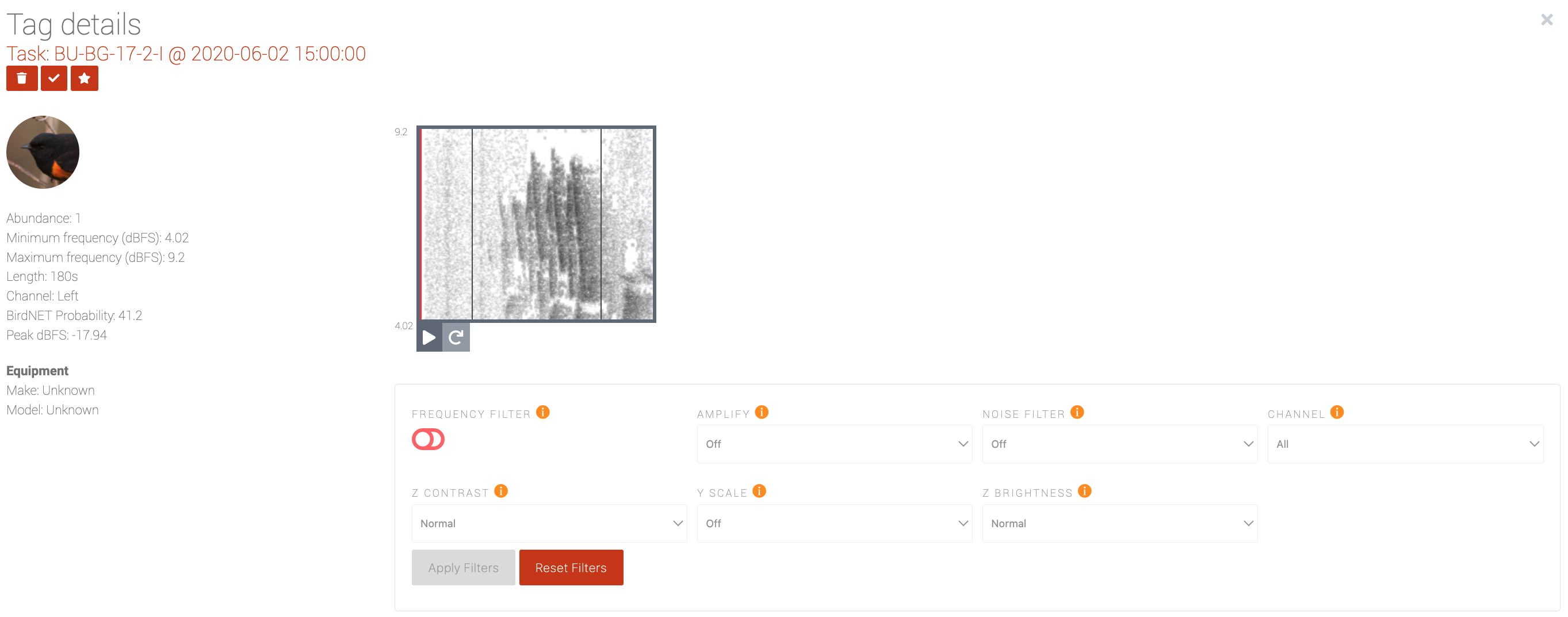
Actions are where you can quickly validate the tag after you've done any filtering or audio manipulation.
 to verify. The icon will turn green when the tag is verified.
to verify. The icon will turn green when the tag is verified. to rate the tag following eBird guidelines.
to rate the tag following eBird guidelines. to delete. This will delete the tag from the system. The changes will also be tracked in the audit table of the task.
to delete. This will delete the tag from the system. The changes will also be tracked in the audit table of the task.
Tag details in the left column summarize other useful information about the media and tag in order to help make a decision on the verification of the tag.
- Minimum frequency: minimum frequency of the tag
- Maximum frequency: maximum frequency of the tag
- Length: length of the recording (seconds)
- Default channel: indicates the channel used for default verification. If one of the channels were malfunctioning, the better channel will appear by default.
- BirdNET probability: maximum value returned from BirdNET
- Peak dBFS: maximum amplitude of the tag
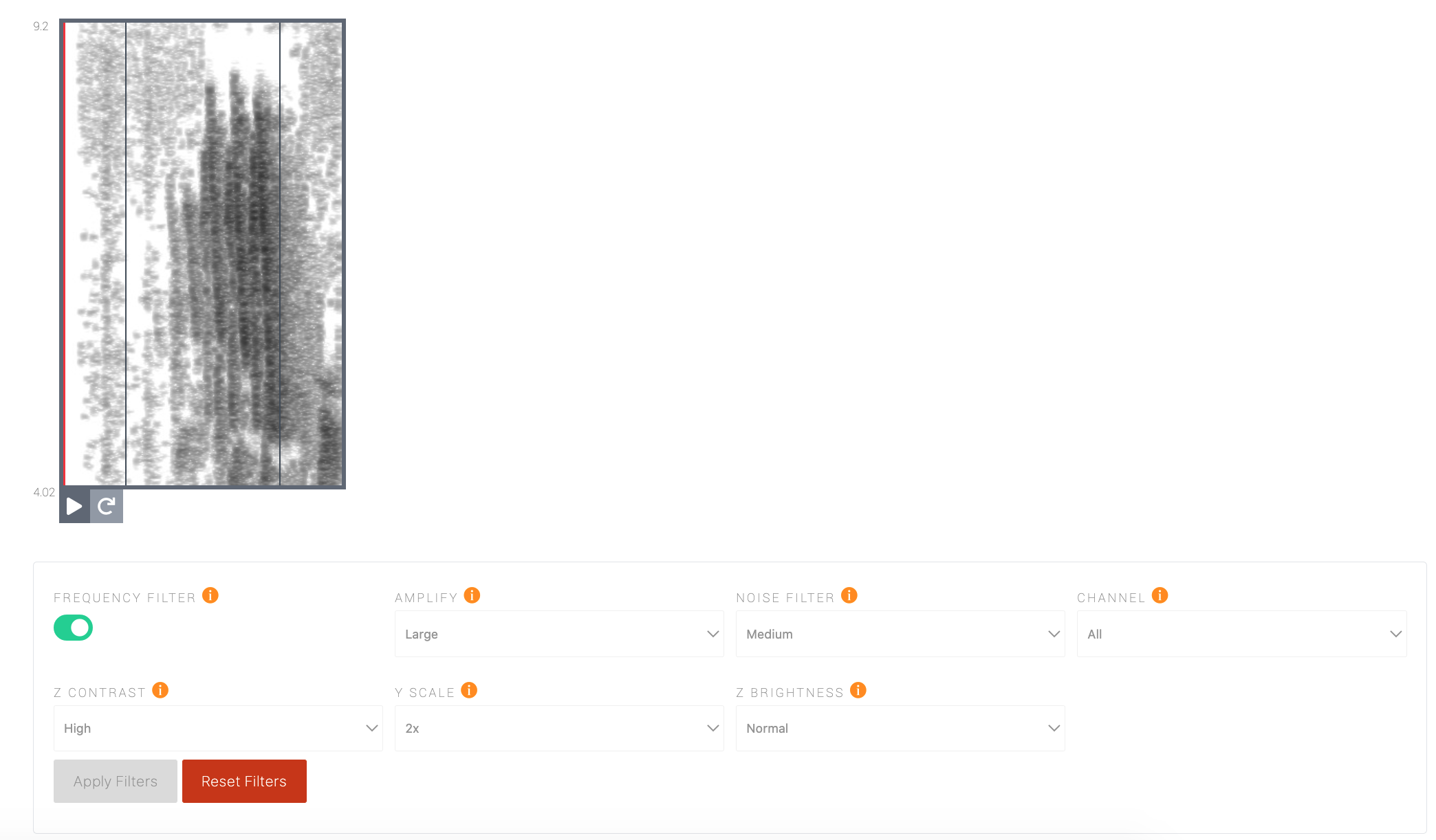
You can manipulate the audio and spectrogram using the different filters and editors located below the tag. These include the following settings that you can combine is any way you'd like to generate the best looking and sounding spectrogram in order to verify the tag.
- Amplify: increases the gain, or amplitude, of the media. Options are:
- Noise filter: runs a noise profile on the tag and attempts to eliminate noise. Options are:
- Channel filter: Select the channel you want to display and listen to (Left or Right). By default, the left channel is visible while both channels are audible.
- Z Contrast: Contrast range in dB. Default is 120 dB. This sets the dynamic-range of the spectrogram to be the selected value dBFS to 0 dBFS. This may range from 20 to 180 dBFS. Decreasing dynamic-range effectively increases the ‘contrast’ of the spectrogram display, and vice versa.
- Z Brightness: Sets the upper limit of the Z-axis in dBFS. A negative number effectively increases the ‘brightness’ of the spectrogram display, and vice versa.
- Y Scale: Expand the number of pixels displayed on the Y axis. Default is 1x. A larger number stretches the spectrogram vertically.
- Frequency filter toggle: when turned on, limits the audio file to playing only the frequency bounds of the tag. Helpful for eliminating other bandwidths to more clearly hear the signal.